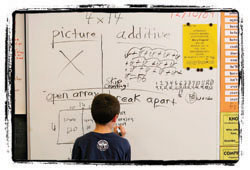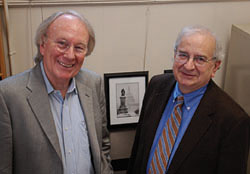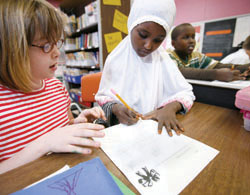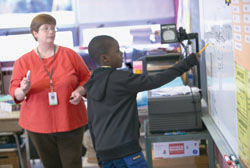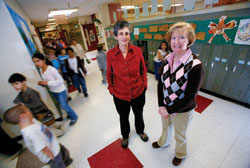Charting Paths to Learning
A team at TC is trying to promote a national effort to develop better tools for teachers to monitor what kids understand and how their learning is progressing
JFK Elementary School in tiny Winooski, Vermont, is spacious and clean, its classrooms stocked with computers and SMART Boards. The students are well behaved, and the faculty is a bright, dedicated group that regularly receives professional development.
Winooski is a mostly low-income town, and about 72 percent of its students are eligible for free or reduced lunch. Through the Vermont Refugee Resettlement Program, the town, which sits just outside of Burlington, also has become home to a growing number of children from Vietnam, Thailand, Bhutan, Bosnia, Somalia and Iraq. In all, 25 percent of the children at JFK do not speak English as a first language.
Over the last 15 years the staff at the school has focused its energy on reading and writing and, despite the school’s demographics, has consistently made adequate yearly progress (AYP) in these areas as mandated under the federal No Child Left Behind Act (NCLB).
But since 2007, the school has not made AYP in mathematics, putting it at risk of added state oversight and sanctions.
To Tom Corcoran and Fritz Mosher, leaders of the Center on Continuous Instructional Improvement (CCII) at Teachers College, JFK Elementary School exemplifies both the growth being made by schools and the challenges they still face as a consequence of American education policy over the past decade.
Corcoran and Mosher have worked for years on improving teaching. Corcoran, among other roles, was Policy Advisor for Education to New Jersey Governor Jim Florio, and he is at the center of TC education partnerships in Jordan, Thailand and other countries. Mosher, a social and cognitive psychologist, served for many years as a program officer with the Carnegie Corporation of New York, and more recently for periods as an advisor to the Spencer Foundation, the RAND Corporation and the U.S. Department of Education’s former Office of Education Research and Innovation. CCII is part of the Consortium for Policy Research in Education (CPRE), founded by TC President Susan Fuhrman.
In a recent report, the two (together with Aaron Rogat, Senior Scientist, CPRE–Teachers College) describe “a set of grand bargains” over the past decade in which states have pledged that all students will become proficient, meeting increasingly ambitious content and performance standards. In exchange, the states receive federal funding targeted to help poor and disadvantaged children. Each state also has been left free to set its own standards and thus determine what constitutes “proficiency”—and districts and schools, in theory, have been left free to determine how best to enable students to meet the standards, while sharing accountability for ensuring that they do so.
That bargain needs to be renegotiated, according to Corcoran and Mosher, because it assumes we know how to prepare all students to reach proficiency levels and it does not encourage adoption of evidence-based practices. There are also issues about what constitutes success. Current assessments tend to emphasize basic skills and memorization of facts, and do not reflect all of the outcomes society wants for its children. By leaving these decisions to the states, NCLB in effect permits them to choose lower proficiency standards, thus creating the appearance of higher rates of success.
To address these issues, critics are demanding a shift to national content and performance standards on a par with results for the highest-performing among other nations. While such reforms sound persuasive, in practice they will mean that schools like JFK Elementary, already laboring under the demands of NCLB, will face even steeper odds. And to Corcoran and Mosher, they will fail unless policymakers address what was neglected in the original bargain: the need to equip teachers with curricula and other teaching tools that help monitor students’ understanding and guide effective interventions to promote their learning.
Specifically, the two men argue that current standards and curricula in many subjects are, in the famous words of Michigan State University’s William Schmidt, “a mile wide and an inch deep”—laundry lists of too many disconnected bits of information and procedural rules. They champion instead a focus on smaller sets of concepts and practices that research has shown to be central to understanding different disciplines and supportive of continued learning.
Over the past decade, researchers and educators around the country have begun to “engineer” sequences of learning experiences aimed at building a deep understanding of these core concepts. More specifically, they have mapped pathways toward increasingly sophisticated understandings of such concepts—sequences based on empirical evidence of how students’ understanding develops and where it might break down. Such evidence includes research on the teaching and learning of a discipline, including evidence of children’s typical levels of understanding at different points in time given adequate instruction.
Corcoran, Mosher and others doing this work call these empirically grounded sequences “learning progressions,” or in some disciplines, “learning trajectories.” The term has been around for at least a decade, but as Corcoran and Mosher define them, learning progressions should focus on important concepts in a discipline and include intermediate levels of achievement. Learning progressions also are both defined and validated by assessment of student achievement—and the progressions, in turn, serve as a basis for designing more effective curriculum and more sensitive and useful assessments referenced to the levels of progress the progressions describe.
What does a learning progression actually look like?
One example in mathematics is the OGAP Multiplicative Reasoning Framework, which evolved from the Vermont Mathematics Partnership’s Ongoing Assessment Project (OGAP).
Beginning in 2003 Marge Petit, a nationally known math consultant, facilitated a Vermont Mathematics Partnership design team charged with developing formative assessment tools and resources. The OGAP team distilled mathematics education research focused on how students develop understanding of mathematical topics, common errors they make, and misconceptions and preconceptions that may interfere with their learning of new concepts or solving related problems. The team used these findings to develop formative assessment probes (short, focused questions, based on research, which teachers could use to monitor students’ understanding); designed tools to gather evidence and inform instruction; and created professional development materials to communicate the mathematics education research to educators and prepare them to use the new tools. This work was informed by three studies conducted between 2004 and 2007 involving hundreds of teachers and thousands of students, which provided the basis for the development of OGAP Frameworks for fractions, multiplicative reasoning and proportionality.
The OGAP Multiplicative Reasoning Framework—more fully developed over the last two years by Petit and another consultant, Beth Hulbert—is, in essence, a map that identifies students’ stages of learning as they develop their understanding of multiplication and division concepts and, ultimately, efficient and generalized strategies for solving multiplication and division problems. The map helps teachers track and advance students along a learning continuum/trajectory.
In training sessions on how to use the OGAP Multiplicative Reasoning Framework, Petit and Hulbert encourage teachers to focus on the strategies students are using rather than simply on the accuracy of their answers, because both provide important information to guide instruction.
“It’s okay for a third grader to use an additive strategy to solve a multiplication problem—for instance, answering 3 x 5 by adding 5 + 5 + 5,” Petit says, “but not for a fifth grader who’s been given a problem such as 24 x 134. By fifth grade, students should understand the concepts underlying multiplication and division and be using efficient algorithms. Fifth grade students who answer multiplication problems correctly but use repeated addition will be at a significant disadvantage as they engage in middle school mathematics dependent upon strong multiplicative reasoning, like proportionality and functions. In addition, because students might retreat to less sophisticated strategies as they solve more complex problems, they often move back and forth in using multiplicative and adding strategies. So we encourage teachers to be very aware of the structures of problems they assign, and to vary those structures depending on the problems kids are having.”
Ultimately, Petit says, the challenge is “how to move students to the kind of understanding that lets them flexibly solve problems with efficient and accurate strategies regardless of the complexity of the problem—so they own it.”
The OGAP Frameworks are in widespread use in schools in Alabama and Vermont—including at JFK Elementary, where, on a snowy afternoon this past December, teacher Pat Keough was working with a group of fourth graders.
Keough had begun the class by setting students the following problem:
It takes four feet of ribbon to make one bow. How many feet of ribbon does it take to make 14 bows?
A girl named Jazlyn, with an orange cast on her left arm, had written out the numbers 1 through 14, and then, above them, counted by fours up to 56. It looked like this:
4 8 12 16 20 24 28 32 36 40 44 48 52 56
1 2 3 4 5 6 7 8 9 10 11 12 13 14
A boy named Abraham drew an open area model (see below) in which he broke 14 into 10 + 4, multiplied 4 x 10 and 4 x 4, and then added their products together. The area model is a transitional strategy that helps students visualize the distributive property (e.g., 4 x 14 = 4 (10 + 4) =
4 x 10 + 4 x 4).
4 x 10 + 4 x 4).
And a girl named Nasteho, wearing a white head scarf, went directly to using the distributive property by breaking apart the numbers without the need for an area model.
(4 x 10) + (4 x 4)
40 16 = 56
Clearly, using the Multiplicative Framework gives a teacher a different perspective on these student efforts than would be gained by simply looking at whether the answer was correct. Keough’s three students were displaying different levels of understanding. The OGAP Multiplicative Framework also guides teachers on how to plan their next day’s instruction—for each child. Over the next few class sessions, Keough would be looking for ways to build on Jazlyn’s skip counting as a starting point for using arrays and area models. She would be helping Abraham to articulate the distributive property that his area model represents.
“Teachers coming from college today have typically taken one or two math content courses,” says JFK Principal Mary O’Rourke. “Most of them are like I was—they’ve memorized some formulas, but they don’t have a conceptual understanding of how mathematics works. And in this school, we’re asking them to teach kids who just got off a plane, who can’t read enough English to take the math assessment, and some who have never been in a school setting who don’t know really know what numbers are. So what the OGAP Frameworks do is really incredible. They help our teachers focus on and understand the instructional implications of the evidence provided by student work and show us how to move students forward based on that, wherever they are.”
Thanks to the initiative of Tom Corcoran and Fritz Mosher, OGAP, CPRE and a company called Wireless Generation are developing a technology-based tool grounded in the OGAP Multiplicative Reasoning Framework and formative questions. Through the use of wireless technology, teachers will be able to access OGAP questions, classify student work according to the strategies a student uses to solve problems, and store and track this information by student, as well as by the student’s class, problem type and other factors.
“The vision is for teachers, at a glance, to be able to see where their students are located along the continuum—at the moment and across time—for the sole purpose of informing instruction and student learning,” Petit says.
More broadly, Corcoran and Mosher are trying to encourage development of a field of research, design and development centered on “adaptive instruction”—again, teaching that is continually informed and improved by monitoring what students know and placing them in a continuum or progression that reveals their progress toward proficient understanding. In spring 2009, they produced a widely disseminated report, “Learning Progressions in Science,” which recommends, among other things, that states revise their standards to consider the evidence on learning progressions. They expect to soon publish a parallel report on math.
“Only if we behave like scientists and adopt scientific practices to inform our educational policies are our students likely to be able to make significant gains in science, and in other domains of knowledge as well,” they write in “Learning Progressions in Science.”
There are signs that others are coming around to that viewpoint—in particular, educators involved in the effort to produce Common Core Standards, a set of national “college- and job-ready” standards in mathematics and English for high school seniors. As of September, 48 states were participating in this initiative, which is being led by the National Governors Association and the Council of Chief State School Officers.
This past summer, at a two-day meeting at the Friday Institute at North Carolina State University hosted by Jere Confrey, the Joseph D. Moore Distinguished Professor of Mathematics Education, participants from the CCII mathematics working group made the case to top people from the Common Core initiative that learning progressions could provide a basis for informing the work of the core standards writing groups as they map the route to reaching standards back over the earlier grades. Separately, Corcoran has been asked to serve on a National Research Council study committee that is launching an effort to create national science standards.
“How it will all play out, we can’t say, but I think it’s safe to say we’re having an impact on people’s thinking,” Corcoran says.
For teachers working in schools like JFK Elementary and for their students there’s a lot riding on the development of tools like the OGAP assessments and on building teachers’ understanding of the implications of the evidence such tools can provide. If those things can happen, then NCLB’s goal of helping each child reach proficiency becomes more than mere political rhetoric.
Published Thursday, Apr. 1, 2010
